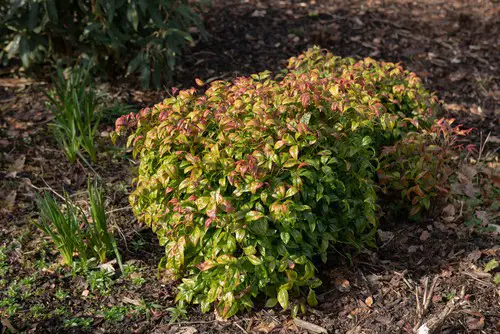With a name like firepower nandina, how can you resist adding this distinctive shrub to your garden? Watching leaves go from deep red to crimson in the fall is truly spectacular, as the leaves of this shrub will evolve as each season passes.
Unlike some other companion plants, the top 10 firepower nandina companion plants aren’t necessarily the best choices because they provide some kind of benefit to this nandina.
The firepower nandina has more than enough tenacity to persevere year after year; instead, these companions either like the same living conditions or just look nice next to your firepower nandina.
Many of the companion plants for firepower nandina are also really easy to take care of, and will come back year after year.
Top 10 Firepower Nandina Companion Plants
You can stick to shrubs or plants that only produce leaves, or you can find companions that will produce flowers. The choice is yours based on how diverse and creative you want your garden or landscape to be.
With plants that change between seasons, you can enjoy something different each season when you admire your yard.
Other companion plants suitable for your garden:
1. Loropetalum
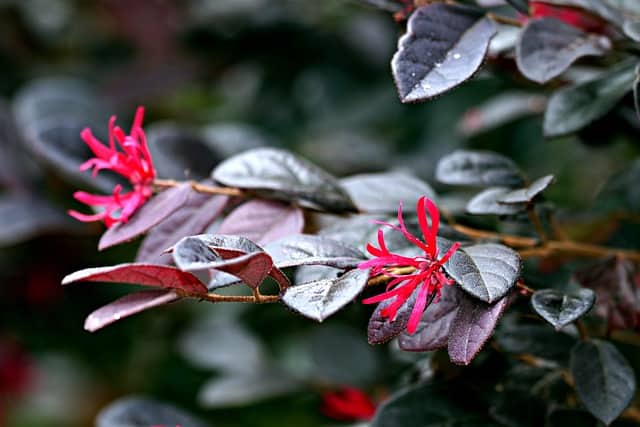
The loropetalum makes for a nice companion to firepower nandina despite how similar they look. Both shrubs enjoy the same living conditions, but one thing to be cognizant of is whether or not your local climate suits both plants.
Mature Size: The mature size range for loropetalum is between 10 and 15 feet tall and wide.
Flowering: You can plant loropetalum all year round, though you’ll have to give it extra water in warmer months.
Key Features: This evergreen shrub boasts several small, dark green leaves with dark purple or red edges, and speckles of bright red flowers with thin and short petals.
2. Ornamental Grass

Having ornamental grass, no matter which kind you choose, will add some depth and visual interest around your firepower nandina. This is accomplished with its variation in height, coloring, and texture.
Mature Size: Ornamental grass can either grow low to the ground or up to 15 feet tall based on your chosen variety.
Flowering: The best time to plant most kinds of ornamental grass is the spring.
Key Features: Ornamental grass tends to be tall, wispy, and comes in different shapes and colors; most are also pretty low maintenance and come with few problems.
3. Hellebore
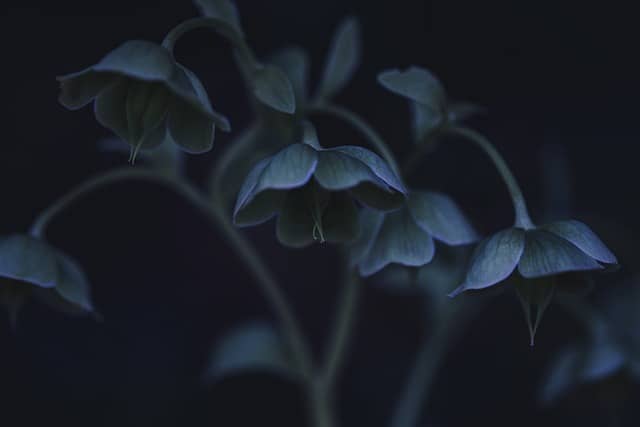
Hellebore plants produce a plethora of colored flowers, so you can get creative with how you’d like to mingle this top choice with your firepower nandina in terms of color variation. For best results, plant hellebore in the shadier spot, and let your firepower nandina take most of the sun.
Mature Size: A mature hellebore plant can reach heights between 18 and 24 inches.
Flowering: Hellebore is ready to plant when the ground isn’t frosty or too hot, so either in the spring or fall.
Key Features: The hellebore grows slowly, and produces a variety of colored flowers on tall, green stems with green leaves. The color of the flowers will depend on the variety planted.
4. Coral Bells
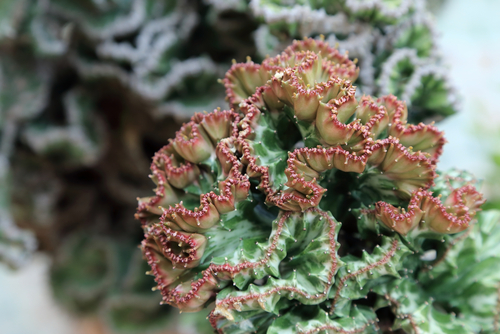
Coral bells create a nice contrast with firepower nandina, especially if you choose a variety that has speckles of gold on its leaves. These can also help fill up a shadier area of your garden, since they can thrive without a ton of sun.
Mature Size: At maturity, coral bells can expand widths of 12 to 24 inches, and can grow to heights of eight to 18 inches tall.
Flowering: The best times to plant coral bells are early spring or late fall.
Key Features: Coral bells are a bush featuring leafs similar to maple trees, coming in many colors from golds to greens to reds.
5. Camellia
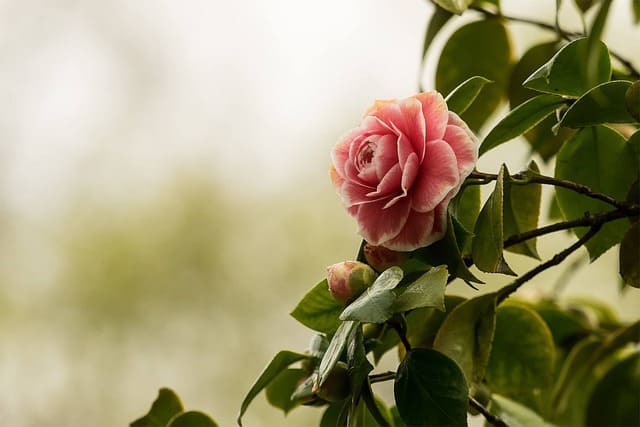
Camellia shrubs add striking color to your landscape not only when they produce flowers, but even when they’re all green. When you plant your camellia strategically, it can take the shade so your firepower nandina gets enough sun.
Mature Size: These shrubs usually grow between 6 and 12 feet, but have been seen up to 25 feet tall.
Flowering: Plant your camellia in either early spring or in the fall.
Key Features: Camellia shrubs sport slightly waxy green leaves and produce either pink, red, or white flowers with wispy layered petals.
6. Roses

A rose bush likes the same weather elements and soil conditions that firepower nandinas like, so they make a good pair. Rose bushes are also easy to maintain and, of course, produce some coveted florals.
Mature Size: A rose bush usually grows between 4 and 6 feet, but can grow taller based on variety.
Flowering: Plant rose bushes in the spring once the final frost of winter is gone.
Key Features: Rose bushes grow green, waxy leaves and produce rose flowers with distinct aromas; color depends on the variety of bush chosen.
7. Dwarf Birch
The dwarf birch shrub is a hardy shrub that is strong enough to withstand the weather all year round. As such, it makes a nice companion to firepower nandina, and offers an interesting contrast in color.
Mature Size: A mature dwarf birch is typically between 6 to 48 inches tall.
Flowering: Plant a dwarf birch in the spring.
Key Features: The dwarf birch features long and thin branches with small leaves that range from yellow to green.
8. Pittosporum
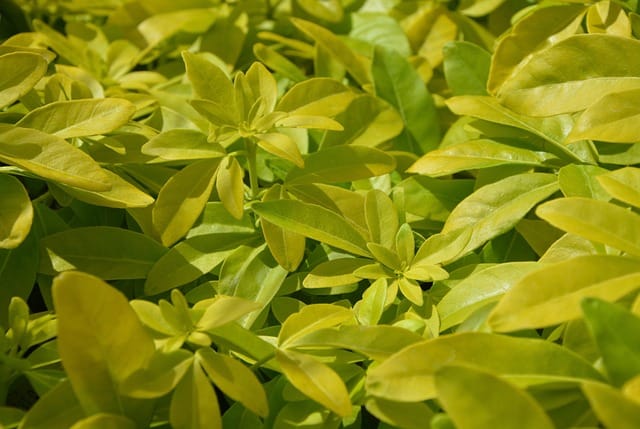
This particular shrubbery makes for a great border around your garden, or even works as a hedge near your garden. Pittosporum is also easy to care for as this plant is highly tolerant of a variety of soil and sun conditions.
Mature Size: Mature pittosporum can reach heights of 12 feet tall.
Flowering: Plant your pittosporum in either the spring or fall season.
Key Features: Pittosporum grows either green and waxy leaves or leaves with touches of white, and produces groups of small white flowers that smell divine.
9. Hydrangeas

Hydrangeas make excellent companions to firepower nandinas because both plants require the same care, and like the same soil and sun types. Since you have so many options for hydrangeas in terms of color, you can truly get creative.
Mature Size: Hydrangeas can grow between two and six feet tall.
Flowering: The ideal time for hydrangea planting is early spring or fall.
Key Features: Hydrangeas are a green bush that produce fairly substantial flowers in multiple colors, with bundles of soft, small petals making up each flower.
10. Golden Japanese Forest Grass

This gorgeous ornamental grass adds a touch of bright green to your landscape. This grass also likes good, well-draining soil, and is pretty adaptable to sun and shade.
Mature Size: At maturity, golden Japanese forest grass can expand 12 to 18 inches tall and up to 24 inches wide.
Flowering: This grass can be planted in spring or fall.
Key Features: This grass features long, thin blades of wispy grass that have touches of gold and bright green.
Summary
Firepower nandina is a really spectacular plant with a lot of potential, adding true fire power to your garden, hedge, or yard. While it stands out dramatically on its own, there are so many ways to complement it with the top 10 firepower nandina companion plants.
With the above choices in companion plants, you get a range in color, heights, and overall appearance to make your yard something extraordinary.
Since these companions are also easy to care for, they make for a great choice alongside the easygoing firepower nandina, so even if you’re a beginner gardener, you can make it work.
Frequently Asked Questions
How Big Does Firepower Nandina Get?
This particular type of nandina is classified as a dwarf plant, but it can still reach heights between two and three feet tall. The same is true of its width; the firepower nandina can be two to three feet wide when it has finally finished growing.
Where Is The Best Place To Plant Nandinas?
The best place to plant nandinas is one that gets a good amount of sun that has some semblance of protection from high winds. Nandinas also like their soil to stay a little bit acidic as well, but overall, firepower nandinas are pretty adaptable when there are slight changes to soil conditions.
How Fast Does Nandina Firepower Grow?
Nandina firepower doesn’t grow especially fast, and it usually takes a few years for it to reach its full mature size. Since the firepower nandina is a dwarf, it reaches full size a bit faster than other nandinas. You can expect yours to grow up to a foot each year.

Hey, I’m Lisa and I’ve been an avid gardener for over 30 years. I love writing, talking and living in the garden! Feel free to connect with me on my socials below

